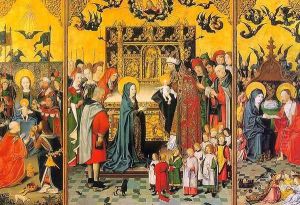Master of the Holy Kindred Paintings
The Master of the Holy Kindred is a notional name given to an unidentified and anonymous Netherlandish painter or group of painters active during the late 15th century. The name is derived from a series of artworks depicting the Holy Kinship, a popular subject in medieval and early Renaissance art, which emphasizes the extended family of the Virgin Mary. This thematic focus on the Virgin’s family, including Saint Anne, her husband Joachim, their daughter the Virgin Mary, and the Christ Child, along with related saints, was a favored narrative, reflecting contemporary devotional practices and the veneration of the Virgin Mary and her ancestry.
The Master of the Holy Kindred’s work is characterized by its detailed depiction of domestic and familial intimacy, set within religious narratives. The paintings often feature rich, vibrant colors, meticulous attention to detail, and elaborate backgrounds that include landscapes or architectural elements. These characteristics align with the broader trends of the Northern Renaissance, such as an emphasis on realism, a deep interest in nature, and the use of oil paint to achieve luminous color effects and detailed textures.
The precise identity of the Master of the Holy Kindred remains a mystery, much like other master painters of the period who are known only by the names of their most famous works or distinctive styles. Art historians and scholars attempt to piece together their identities through stylistic analysis and comparison with known works by other artists of the time. The Master of the Holy Kindred’s oeuvre likely includes altarpieces, devotional panels, and perhaps illuminated manuscripts, though the exact number and full range of works attributed to this artist or group of artists continue to be the subject of research and scholarly debate.
Despite the anonymity, the Master of the Holy Kindred’s contributions to Netherlandish art are significant. Through their intimate and detailed portrayals of sacred familial bonds, these works offer insights into the social and religious values of the time, reflecting both the humanist interests of the Northern Renaissance and the enduring appeal of the Virgin Mary and her family as subjects of devotion and artistic representation. The works attributed to the Master of the Holy Kindred continue to be studied and appreciated for their beauty, technical skill, and the light they shed on a pivotal period in European art history.
